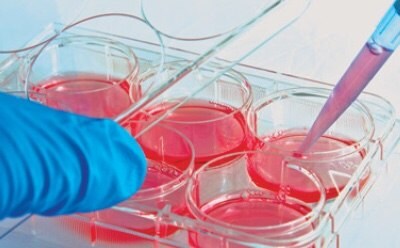Medium 199

Medium 199, often referred to as M199, is a cell culture medium developed by J.F. Morgan in 1950. It emerged as an early synthetic medium for cultivating chick embryo fibroblasts and other mammalian cells in laboratory settings. The composition of Medium 199 can vary slightly depending on the specific requirements of the cell line being cultured, however, the basic formulation typically includes salts such as potassium chloride, sodium chloride, calcium chloride, and magnesium sulfate.
Medium 199 also contains various essential and non-essential amino acids, glucose, cholesterol, pyrimidines, and vitamins, including thiamine, riboflavin, and biotin. It does not contain proteins, lipids, or growth factors; instead, M199 utilizes a sodium bicarbonate buffer system (2.2 g/L) and requires a 5-10% CO2 environment to maintain a physiologically suitable pH.
Medium 199 is available in several different formulations, which can include Earle's salts or Hanks' salts,
L-Glutamine, HEPES, stable glutamine, and sodium bicarbonate, and is available in both liquid and powder forms. The liquid form comes pre-prepared and ready to use, while the powder form refers to the dehydrated version that needs to be reconstituted with sterile water or a buffer solution before use.
Read more about:
Products
Medium 199 Applications
Medium 199 was originally designed for chemically defined and animal component-free culture conditions, making it highly suitable for virology and vaccine production, including the large-scale manufacturing of vaccines. Additionally, M199 played an important role in the polio vaccination campaign of 1955. Its broad range of applications also extends to biologics production, drug screening, and toxicology studies, facilitating advancements in medicine and biotechnology.
Medium 199 vs DMEM
Dulbecco's Modified Eagle's Medium (DMEM) and Medium 199 are two commonly used cell culture media with some distinct differences. Compared to Medium 199, DMEM typically contains higher concentrations of amino acids, vitamins, glucose, and inorganic phosphate. The higher nutrient content in DMEM allows it to support the growth of a wide range of cell lines.
DMEM also utilizes a phosphate buffer system, enabling it to maintain pH stability without the need for additional CO2. Medium 199, however, employs a sodium bicarbonate buffer system and requires a 5-10% CO2 environment to maintain physiological pH.
The differences in composition and pH regulation make DMEM and Medium 199 suitable for different cell culture requirements. Researchers should choose the appropriate medium based on their specific experimental needs.
Um weiterzulesen, melden Sie sich bitte an oder erstellen ein Konto.
Sie haben kein Konto?